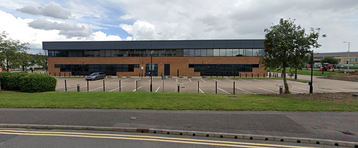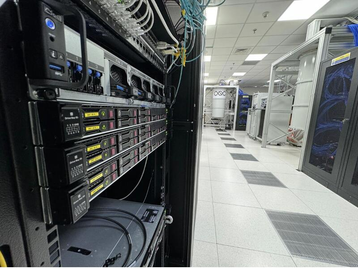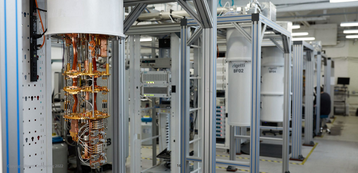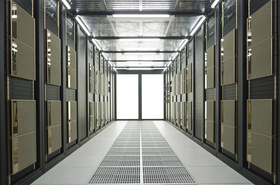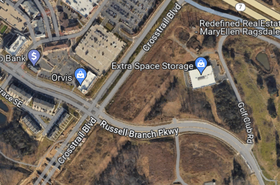We are now reaching the point where quantum computers are being deployed into data centers, leading to new learnings for data center operators and quantum companies alike.
Data center operators are having to come to terms with hosting dilution fridges with new cooling requirements, while quantum computing and dilution fridge providers are having to learn how data centers operate and where they can fit into existing data facilties.
Quantum computers come to colocation facilities
In what DCD understands is a world-first, UK quantum computing firm Oxford Quantum Computing (OQC) has deployed six of its QPU systems in two colocation data centers.
“We wanted to avoid just sitting in a lab in stealth for two years, and pop out and expect people to have already made applications for it,” says Simon Phillips, OQC CTO. “What we need to do is allow access.”
The company currently operates a lab in Reading, hosting its eight-qubit Lucy system, which is accessible online through AWS’s Braket service. Phillips tells DCD the decision to deploy into colo sites was made in the wake of Storm Arwen in 2021.
“We had a power brownout, and that meant that one part of the computing stack could not restart properly,” he explains, leading to the system warming up. While the system was undamaged and re-cooled, it made the company realize it needed to consider uptime more seriously.
“We're trying to demonstrate to the world that computers are ready to start using, and it's not good enough for it to go off. But this has already been solved; there are these data centers around that have all this infrastructure.”
At the same time, a proof-of-concept project was at risk of stalling because the customer said it couldn’t have live data leaving its environments into a lab facility.
“Suddenly the penny dropped that the data center was full of our customers,” says Phillips. “The mission became clear that to actually access real-world customer data outside of research projects, we have to connect directly to people's infrastructure in the lowest latency way.”
The company has deployed three 32-qubit systems in each of Cyxtera’s LHR3 facility in Reading, UK, and Equinix’s TY11 facility in Tokyo, Japan.
In terms of each deployment, one of the OQC systems is live and customer-facing; the other two are live but held for upgrades, testing, etc. Each of the three QPU and accompanying cooling systems requires around 15-20kW (mostly going towards the six 9kW water-cooled helium compressors), but on a footprint described by Phillips as around 14x10 600mm floor tiles.
OQC first reached out to Cyxtera in March 2022; the first fridge was installed in January 2023, and the final fridge in March. Facility work continued until April, after which testing began. The systems are now live.
The Cyxtera deployment is in an enclave room in a former tape library from the company’s CenturyLink days.
“That room was good because we could achieve a watts-per-square-foot that made sense for us,” says Charlie Bernard, Cyxtera’s EMEA director for growth strategy. “We could get enough power in there, there was enough air cooling to make it work, and there is plenty of pipework under the floor.”
While the system was taller than the room ceiling height – 3.4m with an additional 50cm of overhead clearance required for pipework – the single-story facility has a large ceiling void so Cyxtera had extra wiggle room to work with.
Modifications to the ceiling and fire alarm system had to be made to allow for sufficient overhead clearance. Through a raised floor environment, the frame of the multi-ton system was attached directly to the slab and mechanically isolated from the raised floor.
Each dilution fridge requires up to 40 liters of liquid nitrogen to be pumped into the fridges each week. For the chilled water-cooled compressors, Cyxtera had to tap into the building’s water pipework.
To accommodate liquid helium and hydrogen, the company also installed oxygen detectors in the room with light indicators and alarms to show if there’s a potential leak or if gas is boiling off.
“We're taking them on that journey of what it means to deploy into a data center, because they’ve been working their design in something of a silo,” says Bernard. “I think it's been eye-opening for them, coming to see our facilities and learning about things like weight limitations, door sizes, noise, interference, and so on.
“There's been that knowledge share of us to them, also there's been us reaping the benefits for us learning the practices and procedures of handling liquid gases and moving that throughout the building.”
Phillips adds of his company’s learnings: “There was a maturity aspect around language and where the demarcations of responsibilities are. In a lab, everything's everyone's responsibility. Now there's a line which something like chilled water is their responsibility and a line at which is our responsibility.”
The Cyxtera site also doubles as OQC’s network operations center, with a number of the company’s staff on-site daily. In Tokyo, the OQC deployment is in a cage in the data hall, with that deployment designed to be remotely managed, with Oxford Instruments’ in-country service team retained to deal with any issues.
“It's the same team for them that do MRI scanners,” says Phillips. They tour the hospitals, checking all the cryogenics in MRI systems, so it's nothing new to them.”
An interesting component of the Tokyo deployment that the company had to adjust to was the seismic requirements. Cryogenic systems have a liquid nitrogen container that normally sit free-standing on the floor, and the company had to ensure regulatory compliance around how it was bolted to the floor.
Phillips said he expects future deployments to go “a lot smoother” as the company continues to learn and develop its operations.
“We've got the playbook on how do we install superconducting computer into a data center anywhere in the world,” he says. “Every time we go to a new location, we work out where the differences are. To us, they all seem pretty standard; data center people will say they're all different, but we're finding they're very similar compared to labs.
Prior to these deployments, it wasn’t known how different types of interference – sound, vibration, and electromagnetic – would impact deployments in data halls. Likewise, there were potential issues around how the system’s high-frequency microwave controls could impact nearby IT hardware.
Phillips says so far he hasn’t seen any problems around that; when asked if that is solely because of design considerations or perhaps the problem had been overstated, he says likely a mix of both.
“We have done a lot of work around shielding, but we’re yet to see anything that’s creating a problem.”
In terms of operations, the handling of the liquid hydrogen and nitrogen within the facility is managed by the system owner, rather than the colo provider. But data center operators will benefit from understanding how to handle the liquids and potentially manage cryogenic cooling systems.
“There is some learning with how to run all of the systems,” notes Oxford Instruments’ Harriet van der Vliet. “How to close a system properly so that you don't have a leak, how to pump out a system, how to leak check a system. But we're very good at providing training to our users so that they're able to run their systems themselves.”
“That's something that we've had to work on; going from our users being ULT experts who don't need training because they could theoretically just build their own systems, to users who are not experts in cryogenics and do
require some training.”
Both Cyxtera and OQC say they are now better prepared for future deployments.
“Our first install had a very primitive layout. They look very similar to a lab-based thing. But there are a number of projects underway already to make that easier, faster, more suitable, because we're now asking the questions that nobody's ever asked before,” says OQC’s Phillips. “The way the cooling works, or the way the air handling works, no one's ever asked questions before.”
Cyxtera’s Bernard notes the company hopes to replicate this project elsewhere in future: “This was the first deployment, and it's been a great learning curve for all of us. We're in a much better position now.”
OQC said it aims to first expand into more markets, then build out existing deployments with updated form factors as demand increases.
“The biggest barrier to entry for using world – clusters of financial companies in a certain location or material sciences companies in another – that we can target getting them access to a QPU in that location, and then we'll kind of build out and scale from there,” says Phillips. “I think that the solution does lie within colos as a priority.
“The biggest barrier to entry for using quantum computers was actually the integration into existing digital infrastructure, not qubit account. The fact that we're able to have a chat about data centers and quantum computers means it's all moved in the right direction.”
Quantum supply chains learn about data centers
Fridge supplier Oxford Instruments has installed a Rigetti quantum computer at its main site in Tubney Wood, Oxfordshire.
The system – Rigetti’s first outside the US and still one of the few the company has shipped outside its own facilities – is connected to Rigetti’s cloud for its own and its customers’ use.
Harriet van der Vliet, product segment manager, quantum technologies, Oxford Instruments, tells DCD that the company did not have an on-site data center prior to the installation, and still doesn’t have what we’d consider a traditional white space data hall.
“Our factory is not the equivalent of a colocation facility. We provided the fridge and the facility as part of Innovate UK funding so that Rigetti and its partners Phasecraft, Standard Chartered, and others could work on their applications for quantum computing,” she says.
“We had to learn all about having a commercial system with the correct connections to the cloud, backup generators, backup chillers, which you don't necessarily think about in a lab,” she says. “If the power goes out in a university, you just say, ‘okay, I'll warm up and then I'll cool down the next day.’ But if that happens in a data center or system that's connected to the cloud for customers, that's absolutely not okay.”
When asked if the company would look to host more quantum computers in future or this was a one-off, van der Vliet said that there “is always the opportunity to do lots more” in the space.
“We learned about building in redundancy, such as backup generators, chillers, etc. so that the system had good uptime for the customer. It was great working with Rigetti to host their first quantum computer in Europe.”
Beyond its own facility, Oxford Instruments was involved in a number of QPU deployments in live data centers – including OQC’s deployment in Cyxtera and Equinix facilities, and the CESGA supercomputing center in Spain.
“We have now installed various systems into data centers,” says van der Vliet. “We've had to install into different areas, which we're not used to, and be prepared for security having to get people particular badges to get them in and out of data centers, which is something we've not been used to.”
“We had to change how we install systems physically, and getting into the data centers has been indifferent. Some of the data centers might have certain areas which are just ready to wheel a 19-inch rack through and our systems are obviously quite a bit bigger than that.”
“But it’s not really that different [from academic settings]; we have had these issues and difficulties within installs for many years,” she adds.
“It's just about getting that experience. We now have that second and third installation, and both installations were much better than the first.”


